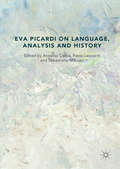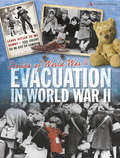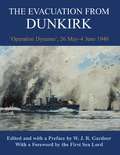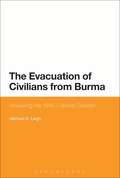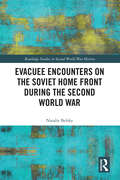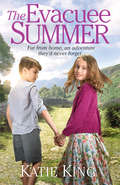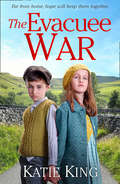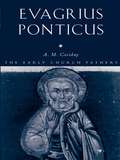- Table View
- List View
Eva Gore-Booth: An image of such politics
by Sonja TiernanThis is the first dedicated biography of the extraordinary Irish woman, Eva Gore-Booth. Gore-Booth rejected her aristocratic heritage choosing to live and work amongst the poorest classes in industrial Manchester. Her work on behalf of barmaids, circus acrobats, flower sellers and pit-brow lasses is traced in this book. During one impressive campaign Gore-Booth orchestrated the defeat of Winston Churchill. Gore-Booth published volumes of poetry, philosophical prose and plays, becoming a respected and prolific author of her time and part of W.B. Yeats’ literary circle. The story of Gore-Booth’s life is captivating. Her close bond with her sister, an iconic Irish nationalist, provides a new insight into Countess Markievicz’s personal life. Gore-Booth’s life story vividly traces her experiences of issues such as militant pacifism during the Great War, the case for the reprieve of Roger Casement’s death sentence, sexual equality in the workplace and the struggle for Irish independence.
Eva Palmer Sikelianos: A Life in Ruins
by Artemis LeontisThe first biography of a visionary twentieth-century American performer who devoted her life to the revival of ancient Greek cultureThis is the first biography to tell the fascinating story of Eva Palmer Sikelianos (1874–1952), an American actor, director, composer, and weaver best known for reviving the Delphic Festivals. Yet, as Artemis Leontis reveals, Palmer’s most spectacular performance was her daily revival of ancient Greek life. For almost half a century, dressed in handmade Greek tunics and sandals, she sought to make modern life freer and more beautiful through a creative engagement with the ancients. Along the way, she crossed paths with other seminal modern artists such as Natalie Clifford Barney, Renée Vivien, Isadora Duncan, Susan Glaspell, George Cram Cook, Richard Strauss, Dimitri Mitropoulos, Nikos Kazantzakis, George Seferis, Henry Miller, Paul Robeson, and Ted Shawn.Brilliant and gorgeous, with floor-length auburn hair, Palmer was a wealthy New York debutante who studied Greek at Bryn Mawr College before turning her back on conventional society to live a lesbian life in Paris. She later followed Raymond Duncan (brother of Isadora) and his wife to Greece and married the Greek poet Angelos Sikelianos in 1907. With single-minded purpose, Palmer re-created ancient art forms, staging Greek tragedy with her own choreography, costumes, and even music. Having exhausted her inheritance, she returned to the United States in 1933, was blacklisted for criticizing American imperialism during the Cold War, and was barred from returning to Greece until just before her death.Drawing on hundreds of newly discovered letters and featuring many previously unpublished photographs, this biography vividly re-creates the unforgettable story of a remarkable nonconformist whom one contemporary described as “the only ancient Greek I ever knew.”
Eva Palmer Sikelianos: A Life in Ruins
by Artemis LeontisThe first biography of a visionary twentieth-century American performer who devoted her life to the revival of ancient Greek cultureThis is the first biography to tell the fascinating story of Eva Palmer Sikelianos (1874–1952), an American actor, director, composer, and weaver best known for reviving the Delphic Festivals. Yet, as Artemis Leontis reveals, Palmer’s most spectacular performance was her daily revival of ancient Greek life. For almost half a century, dressed in handmade Greek tunics and sandals, she sought to make modern life freer and more beautiful through a creative engagement with the ancients. Along the way, she crossed paths with other seminal modern artists such as Natalie Clifford Barney, Renée Vivien, Isadora Duncan, Susan Glaspell, George Cram Cook, Richard Strauss, Dimitri Mitropoulos, Nikos Kazantzakis, George Seferis, Henry Miller, Paul Robeson, and Ted Shawn.Brilliant and gorgeous, with floor-length auburn hair, Palmer was a wealthy New York debutante who studied Greek at Bryn Mawr College before turning her back on conventional society to live a lesbian life in Paris. She later followed Raymond Duncan (brother of Isadora) and his wife to Greece and married the Greek poet Angelos Sikelianos in 1907. With single-minded purpose, Palmer re-created ancient art forms, staging Greek tragedy with her own choreography, costumes, and even music. Having exhausted her inheritance, she returned to the United States in 1933, was blacklisted for criticizing American imperialism during the Cold War, and was barred from returning to Greece until just before her death.Drawing on hundreds of newly discovered letters and featuring many previously unpublished photographs, this biography vividly re-creates the unforgettable story of a remarkable nonconformist whom one contemporary described as “the only ancient Greek I ever knew.”
Eva Palmer Sikelianos: A Life in Ruins
by Artemis LeontisThe first biography of a visionary twentieth-century American performer who devoted her life to the revival of ancient Greek cultureThis is the first biography to tell the fascinating story of Eva Palmer Sikelianos (1874–1952), an American actor, director, composer, and weaver best known for reviving the Delphic Festivals. Yet, as Artemis Leontis reveals, Palmer’s most spectacular performance was her daily revival of ancient Greek life. For almost half a century, dressed in handmade Greek tunics and sandals, she sought to make modern life freer and more beautiful through a creative engagement with the ancients. Along the way, she crossed paths with other seminal modern artists such as Natalie Clifford Barney, Renée Vivien, Isadora Duncan, Susan Glaspell, George Cram Cook, Richard Strauss, Dimitri Mitropoulos, Nikos Kazantzakis, George Seferis, Henry Miller, Paul Robeson, and Ted Shawn.Brilliant and gorgeous, with floor-length auburn hair, Palmer was a wealthy New York debutante who studied Greek at Bryn Mawr College before turning her back on conventional society to live a lesbian life in Paris. She later followed Raymond Duncan (brother of Isadora) and his wife to Greece and married the Greek poet Angelos Sikelianos in 1907. With single-minded purpose, Palmer re-created ancient art forms, staging Greek tragedy with her own choreography, costumes, and even music. Having exhausted her inheritance, she returned to the United States in 1933, was blacklisted for criticizing American imperialism during the Cold War, and was barred from returning to Greece until just before her death.Drawing on hundreds of newly discovered letters and featuring many previously unpublished photographs, this biography vividly re-creates the unforgettable story of a remarkable nonconformist whom one contemporary described as “the only ancient Greek I ever knew.”
Eva Palmer Sikelianos: A Life in Ruins
by Artemis LeontisThe first biography of a visionary twentieth-century American performer who devoted her life to the revival of ancient Greek cultureThis is the first biography to tell the fascinating story of Eva Palmer Sikelianos (1874–1952), an American actor, director, composer, and weaver best known for reviving the Delphic Festivals. Yet, as Artemis Leontis reveals, Palmer’s most spectacular performance was her daily revival of ancient Greek life. For almost half a century, dressed in handmade Greek tunics and sandals, she sought to make modern life freer and more beautiful through a creative engagement with the ancients. Along the way, she crossed paths with other seminal modern artists such as Natalie Clifford Barney, Renée Vivien, Isadora Duncan, Susan Glaspell, George Cram Cook, Richard Strauss, Dimitri Mitropoulos, Nikos Kazantzakis, George Seferis, Henry Miller, Paul Robeson, and Ted Shawn.Brilliant and gorgeous, with floor-length auburn hair, Palmer was a wealthy New York debutante who studied Greek at Bryn Mawr College before turning her back on conventional society to live a lesbian life in Paris. She later followed Raymond Duncan (brother of Isadora) and his wife to Greece and married the Greek poet Angelos Sikelianos in 1907. With single-minded purpose, Palmer re-created ancient art forms, staging Greek tragedy with her own choreography, costumes, and even music. Having exhausted her inheritance, she returned to the United States in 1933, was blacklisted for criticizing American imperialism during the Cold War, and was barred from returning to Greece until just before her death.Drawing on hundreds of newly discovered letters and featuring many previously unpublished photographs, this biography vividly re-creates the unforgettable story of a remarkable nonconformist whom one contemporary described as “the only ancient Greek I ever knew.”
Eva Perón: The Myths of a Woman
by Julie TaylorEva Perón, one of the most powerful women in the world at the time of her death in 1952, rose from humble origins to international renown as First Lady of Argentina and the force behind the throne of her husband Juan Perón. Despite her immense popularity, she was inaccessible to the people of Argentina, and so images were constructed around her to fill that void. According to Julie M. Taylor, these "myths" around Eva Perón reflect Argentine culture and political history at the time of her seven-year reign. With a brief biography of Eva Perón serving as a backdrop, Taylor offers a detailed analysis of the principle myths that grew around this enigmatic woman. "Taylor shows that she is remembered by different classes and political factions as saint, a revolutionary, or a whore, depending on whether she was interpreted as an embodiment or as a violation of the Argentine feminine ideal."—Booklist "Highly commendable . . . it deliberately eschews the sensationalism that characterizes earlier [biographies]. . . . Taylor instead concentrates on the myths that have lingered since her death. . . . [This book] transcends biography."—Gentlemen's Quarterly "[A] concise and brilliant examination of the legends that arose in Argentina during the lifetime . . . of a woman who broke with Argentine tradition and became a political figure in her own right."—New Yorker
Eva Picardi on Language, Analysis and History
by Annalisa Coliva Paolo Leonardi Sebastiano MoruzziThe volume honours Eva Picardi – her philosophical views and interests, as well as her teaching – collecting eighteen essays, some by former students of hers, some by colleagues with whom she discussed and interacted. The themes of the volume encompass topics ranging from foundational and historical issues in the philosophy of language and the philosophy of logic and mathematics, as well as issues related to the recent debates on rationality, naturalism and the contextual aspects of meaning. The volume is split into three sections: one on Gottlob Frege’s work – in philosophy of language and logic –, taking into account also its historical dimension; one on Donald’s Davidson’s work; and one on the contextualism-literalism dispute about meaning and on naturalist research programmes such as Chomsky’s.
Eva Picardi on Language, Analysis and History
by Annalisa Coliva Paolo Leonardi Sebastiano MoruzziThe volume honours Eva Picardi – her philosophical views and interests, as well as her teaching – collecting eighteen essays, some by former students of hers, some by colleagues with whom she discussed and interacted. The themes of the volume encompass topics ranging from foundational and historical issues in the philosophy of language and the philosophy of logic and mathematics, as well as issues related to the recent debates on rationality, naturalism and the contextual aspects of meaning. The volume is split into three sections: one on Gottlob Frege’s work – in philosophy of language and logic –, taking into account also its historical dimension; one on Donald’s Davidson’s work; and one on the contextualism-literalism dispute about meaning and on naturalist research programmes such as Chomsky’s.
Evacuation: Evacuation (Stories of World War II #1)
by A.J. StonesCan you imagine leaving your home and your family, and moving hundreds of miles away to live with strangers, because it was too dangerous to stay in your hometown? During World War II, this was situation millions of people, the majority of them children, faced. Stories of World War II: Evacuation tells the stories of these children: where they came from, where they went, who looked after them, what they ate, and how they went to school, along with many other details about their lives as evacuees.Much of the material on which the book is based comes from The National Archives, and so is made up of government documents and reports from during World War II. This gives the book a real grounding in fact and in history - it is a true account of what life was like for evacuees during World War II.The other book in the series, Stories of World War II: Kindertransport, tells the story of Jewish children evacuated to Britain from Germany, Holland and Austria before the outbreak of World War II.
The Evacuation from Dunkirk: 'Operation Dynamo', 26 May-June 1940 (Naval Staff Histories)
by W.J.R. GardnerThis is the Naval Staff History of "Operation Dynamo", originally published internally in 1949. British ships evacuated nearly 100,000 men of the BEF from the beaches, and over 200,000 from harbours. Other nations' vessels carried more than 30,000.
The Evacuation from Dunkirk: 'Operation Dynamo', 26 May-June 1940 (Naval Staff Histories)
by W.J.R. GardnerThis is the Naval Staff History of "Operation Dynamo", originally published internally in 1949. British ships evacuated nearly 100,000 men of the BEF from the beaches, and over 200,000 from harbours. Other nations' vessels carried more than 30,000.
The Evacuation of Civilians from Burma: Analysing the 1942 Colonial Disaster
by Michael D. LeighThe string of military defeats during 1942 marked the end of British hegemony in Southeast Asia, finally destroying the myth of British imperial invincibility. The Japanese attack on Burma led to a hurried and often poorly organized evacuation of Indian and European civilians from the country. The evacuation was a public humiliation for the British and marked the end of their role in Burma.The Evacuation of Civilians from Burma investigates the social and political background to the evacuation, and the consequences of its failure. Utilizing unpublished letters, diaries, memoirs and official reports, Michael Leigh provides the first comprehensive account of the evacuation, analyzing its source in the structures of colonial society, fractured race relations and in the turbulent politics of colonial Burma.
The Evacuation of Civilians from Burma: Analysing the 1942 Colonial Disaster
by Michael D. LeighThe string of military defeats during 1942 marked the end of British hegemony in Southeast Asia, finally destroying the myth of British imperial invincibility. The Japanese attack on Burma led to a hurried and often poorly organized evacuation of Indian and European civilians from the country. The evacuation was a public humiliation for the British and marked the end of their role in Burma.The Evacuation of Civilians from Burma investigates the social and political background to the evacuation, and the consequences of its failure. Utilizing unpublished letters, diaries, memoirs and official reports, Michael Leigh provides the first comprehensive account of the evacuation, analyzing its source in the structures of colonial society, fractured race relations and in the turbulent politics of colonial Burma.
Evacuee Boys: Letters of a Family Separated by War (History Press Ser.)
by John E. ForbatBrothers John and Andrew Forbat had been happily living in England as patriotic British boys since 1936. When the Second World War broke out, however, the brothers found themselves evacuated to a disadvantaged part of Melksham in Wiltshire, cut off from home and family, and in straitened circumstances. Added to this, on Pearl Harbor Day 1941, Hungary, along with other countries, joined the Axis and the Forbat family became Enemy Aliens. Their many letters home throughout the war, with details of their schooling, bullying, friendships and constant pursuit of more pocket money, form a humorous and at times tragic testament to the hardships of war. Interspersed with diary entries made by the boys’ father back home in Blitz-ravaged London, and letters from Andrew when he was interned on the Isle of Man, Evacuee Boys is as full a record of war-torn Britain as one family could provide.
The Evacuee Christmas
by Katie KingA heart-warming story of friendship and family during the first Christmas of World War Two.
Evacuee Encounters on the Soviet Home Front During the Second World War (Routledge Studies in Second World War History)
by Natalie BelskyThis study is the first to examine the experiences of the millions of Soviet civilians evacuated to the interior of the country during the Second World War in the context of their encounters and relations with local communities and populations across Soviet Central Asia, Kazakhstan, Siberia, and the Urals. The book considers the impact of this episode of massive population displacement across Eurasia on individuals, communities, and society more broadly. It explores how the challenges associated with wartime displacement gave rise to tensions between evacuees and local residents. These frictions, in turn, forced individuals to interrogate the meaning, terms, and limitations of citizenship and belonging in the Soviet Union. Evacuation thus played a critical role in the changing relationship between citizens and the Soviet state in the war and postwar periods. Furthermore, this study pays particular attention to the plight of Soviet Jewish evacuees, who constitute the largest contingent of Holocaust survivors in Europe, and the rise of anti-Semitism on the Soviet home front during the war. This volume will be of interest to students and scholars of the Second World War, migration and displacement, the Holocaust, Soviet Jewish history, and the Soviet experience more broadly.
Evacuee Encounters on the Soviet Home Front During the Second World War (Routledge Studies in Second World War History)
by Natalie BelskyThis study is the first to examine the experiences of the millions of Soviet civilians evacuated to the interior of the country during the Second World War in the context of their encounters and relations with local communities and populations across Soviet Central Asia, Kazakhstan, Siberia, and the Urals. The book considers the impact of this episode of massive population displacement across Eurasia on individuals, communities, and society more broadly. It explores how the challenges associated with wartime displacement gave rise to tensions between evacuees and local residents. These frictions, in turn, forced individuals to interrogate the meaning, terms, and limitations of citizenship and belonging in the Soviet Union. Evacuation thus played a critical role in the changing relationship between citizens and the Soviet state in the war and postwar periods. Furthermore, this study pays particular attention to the plight of Soviet Jewish evacuees, who constitute the largest contingent of Holocaust survivors in Europe, and the rise of anti-Semitism on the Soviet home front during the war. This volume will be of interest to students and scholars of the Second World War, migration and displacement, the Holocaust, Soviet Jewish history, and the Soviet experience more broadly.
The Evacuee Summer
by Katie King‘A heartwarming read’ My Weekly ‘A delightful, nostalgic read’ Woman Magazine Far from home, an adventure they’ll never forget…
The Evacuee War
by Katie KingFar from home, hope will keep them together. The plucky evacuees must come together in this heart-warming saga set in the Second World War for fans of Dilly Court and Rosie Goodwin…
Evacuees: Evacuation in Wartime Britain 1939-1945 (Shire Library)
by Mike BrownMike Brown combines factual narrative with contemporary eyewitness accounts and oral history extracts to look at the evacuation in Britain during the Second World War.
Evader: The Epic Story of the First British Airman to be Rescued by the Comete Escape Line in World War II (Spellmount Ser.)
by Derek ShuffIn 1941 air gunner Sergeant Jack Newton’s Wellington is hit by flak on his first bombing raid over Germany. Miraculously, the skipper makes an emergency landing on a German-occupied Belgian airfield, narrowly avoiding Antwerp Cathedral. Having torched the plane, the crew give the unsuspecting Germans the slip and are hidden by the Resistance. Hoping to make it to the coast and back across the Channel, the airmen are surprised when the 23-year-old female leader of the Comete Escape Line, Andree de Jongh – codenamed Dedee – has other plans for them. Full of terrifying and humorous moments, this is the story of the epic journey of the first British airman to escape occupied Europe during the Second World War.
Evagrius of Pontus: The Gnostic Trilogy
by Robin Darling Young Joel Kalvesmaki Columba Stewart Charles M. Stang Fr. Luke DysingerThe Gnostic Trilogy is the best-known and most important work by the ascetic philosopher and teacher Evagrius of Pontus. Among the writers of his age, Evagrius stands out for his short, perplexing, and absorbing aphorisms, which provide sharp insight into philosophy, Scripture, human nature, and the natural world. The first part of the trilogy, the Praktikos (The Practiced One), provides a diagnosis and treatment of the eight tempting thoughts. It was a foundational text for monastic asceticism and was the basis for the later Seven Deadly sins tradition. The second, Gnostikos (The Knower), explains how someone who has mastered the body and mental delusions should teach others. The third, longest, and most controversial, the Kephalaia gnostika (Gnostic Chapters), ranges broadly over the origin of the universe, the nature of rational beings, and the hidden symbols of Scripture. This part was responsible for Evagrius's condemnation as a heretic and, as a result, does not survive intact in the original Greek and must be restored from ancient translations. This volume presents the Trilogy in its entirety for the first time since antiquity and provides a fresh, comprehensive English translation of all three works, in all their known ancient versions, both Greek and Syriac. Detailed explanatory notes, cross-references to Scripture, to ancient literature, and to Evagrius's other writings, as well as commentary on the translation techniques of the Syriac translators, provide the necessary resources for understanding this significant but puzzling text.
Evagrius of Pontus: The Gnostic Trilogy
by Robin Darling Young Joel Kalvesmaki Columba Stewart Charles M. Stang Fr. Luke DysingerThe Gnostic Trilogy is the best-known and most important work by the ascetic philosopher and teacher Evagrius of Pontus. Among the writers of his age, Evagrius stands out for his short, perplexing, and absorbing aphorisms, which provide sharp insight into philosophy, Scripture, human nature, and the natural world. The first part of the trilogy, the Praktikos (The Practiced One), provides a diagnosis and treatment of the eight tempting thoughts. It was a foundational text for monastic asceticism and was the basis for the later Seven Deadly sins tradition. The second, Gnostikos (The Knower), explains how someone who has mastered the body and mental delusions should teach others. The third, longest, and most controversial, the Kephalaia gnostika (Gnostic Chapters), ranges broadly over the origin of the universe, the nature of rational beings, and the hidden symbols of Scripture. This part was responsible for Evagrius's condemnation as a heretic and, as a result, does not survive intact in the original Greek and must be restored from ancient translations. This volume presents the Trilogy in its entirety for the first time since antiquity and provides a fresh, comprehensive English translation of all three works, in all their known ancient versions, both Greek and Syriac. Detailed explanatory notes, cross-references to Scripture, to ancient literature, and to Evagrius's other writings, as well as commentary on the translation techniques of the Syriac translators, provide the necessary resources for understanding this significant but puzzling text.
Evagrius Ponticus (The Early Church Fathers)
by Augustine CasidayPresenting many texts available for the very first time, this new volume in the successful Early Church Fathers series showcases full translations of Evagrius' letters, notes on various books of the bible, his treatises and his 'chapters'. Augustine Casiday's material is both accurate and refreshingly approachable, and the work is prefaced by a solid introductory essay that presents Evagrius, his work and influences, and modern scholarship in an easy-to-understand way for beginners. For students dealing with Evagrius for the first time, they could not find a better book to begin their exploration of this figure in late-ancient history and theology.
Evagrius Ponticus (The Early Church Fathers)
by Augustine CasidayPresenting many texts available for the very first time, this new volume in the successful Early Church Fathers series showcases full translations of Evagrius' letters, notes on various books of the bible, his treatises and his 'chapters'. Augustine Casiday's material is both accurate and refreshingly approachable, and the work is prefaced by a solid introductory essay that presents Evagrius, his work and influences, and modern scholarship in an easy-to-understand way for beginners. For students dealing with Evagrius for the first time, they could not find a better book to begin their exploration of this figure in late-ancient history and theology.



